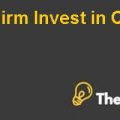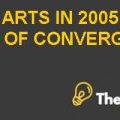Estimating Cisco's Future Cash Flows Case Solution
The businesses’ price to earnings ratio declined from $10.02 in 2015 to $9.6 in 2016 . This indicates that the company’s shares are not demanded by the investors and they are reluctant to invest in the company’s shares. On the other hand, a declining P/E ratio indicates that the company’s shares are undervalued.
The debt to equity ratio indicates the business’s proportion of debt and equity used in order to finance the business’s assets. The company’s debt to equity ratio increased from 42% in 2015 to 46%, which indicates that the company relies more on debt, in order to finance its assets and is experiencing difficulties in reducing the level of debt.
The interest cover of the business decreased to 20 times in 2016 as compared to 33 times in 2015. This shows that the business is facing an increased risk of bankruptcy and its debt burden is severely high against its existing earning potential.
The dividend payout ratio decreased by 1% in the year 2016 as compared to the previous year, which indicates that less amount was paid to the shareholders regarding the net income of the company. This might result in investors’ dissatisfaction and the sustainability of the business’s dividend payment stream.
The dividend yield of the business increased to 3.8% as compared to 2.8% in the previous year, as a result of an increased dividends per share to $0.94 as compared to $0.8 in 2015. Although a high dividend yield provides more income as compared to the share’s price, it also indicates that the share’s price is undervalued, which is evident by the low P/E ratio.
Alternative Analysis
Financial Ratio Analysis
The ratio analysis is a helpful tool in measuring the company’s profitability, evaluating the operational efficiency, ensuring the suitable liquidity and reflecting the overall financial strength. The ratios can be compared with the previous year’s ratios, in order to evaluate the company’s progress over the period of time.
The pros and cons of making the use of financial ratios to predict the future company’s performance, are discussed below:
Pros
It helps in validating or disapproving the investment, financing and operating decisions of the company. The ratios help in evaluating and comparing the financial position of the company as well as the results of the management or investor’s decisions. Furthermore, it allows the investors to conduct a comparison with the industry trends, other firms and intra-firm comparison. This in turn provides valuable insights to understand the financial standing of the company in terms of economy. In addition to this, it helps in understanding the firm’ business risk through calculating the leverages, including: operating leverages and financial leverages. It provides an assistance in evaluating that how profitable the company is, with respect to its debt outstanding and fixed cost deployment.
It also provides valuable insight into the profitability, performance and overall earning power of the business. The trend can be conducted for the future plans and forecasting, which helps investor in decision making. It also simplifies the complex accounting standard and financial data through financial efficiency, operating efficiency, solvency and long-term position.
Cons
The entire data used in conducting ratio analysis is derived from the actual results of the historical data, which wouldn’t help into the future. The information on the income statement of the company is stated in the current cost, whereas the information on the balance sheet of the company is stated in the historical cost, which in turn might cause unusual results in ratios.It illustrates an association between the previous information and data while the investors seek and are more concerned about future and current data.
Discounted Cash Flow Analysis
The discounted cash flow analysis is another method that is used by the investors to estimate the future return on the invested capital for the time value of money.
The pros and cons of using such method to predict the company’s future profitability, are discussed below:
Pros
It is widely used to measure the investment’s attractiveness, over the company’s cash flows. The analysis also includes the future expectations, with an inclusion of the internal rate of return, which is used to estimate the potential investment’s profitability. It can be used to assess the company’s value and profitability, in future. In addition to this, the terminal value helps in determining the company’s position. Furthermore, it includes an intrinsic value of the business and major assumptions related to the business..............
This is just a sample partial case solution. Please place the order on the website to order your own originally done case solution.












